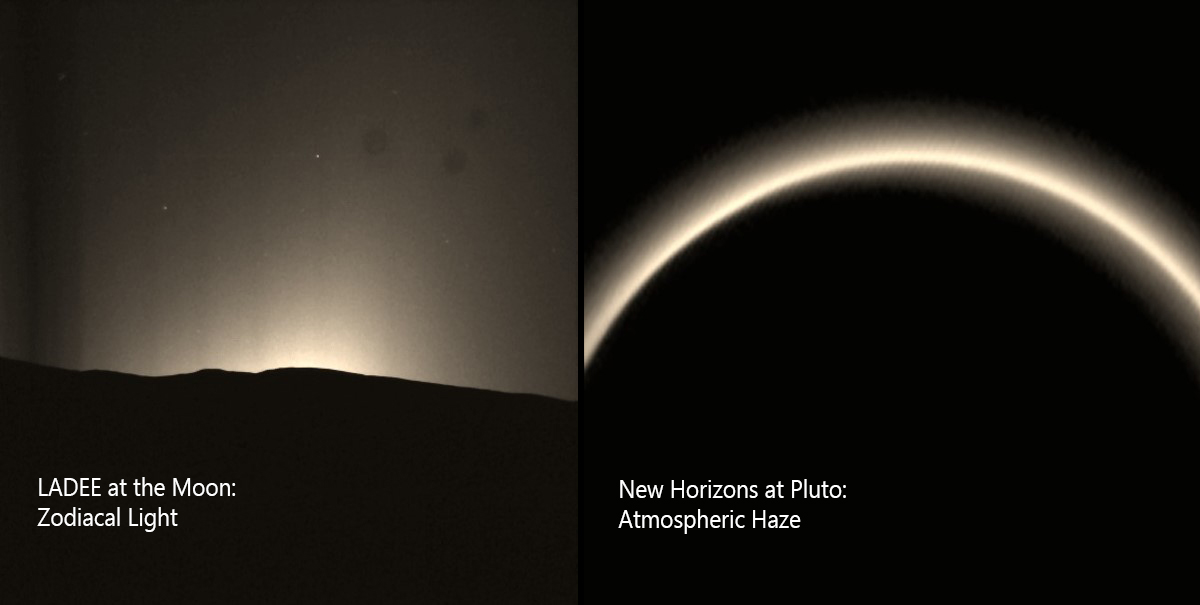
What variety there is in our wonderful solar system! NASA’s MErcury Surface, Space ENvironment, GEochemistry, and Ranging (MESSENGER) spacecraft observed the surface boundary exosphere of the innermost planet, Mercury. The Lunar Atmosphere and Dust Environment Explorer (LADEE) spacecraft has investigated the exosphere of Earth’s nearest neighbor, our moon Luna, and now New Horizons has scrutinized the atmosphere of the outermost planet, Pluto. And Pluto’s atmosphere is very different from the moon’s!
For one thing, apparently Pluto’s atmosphere has enough gas, of the right chemical composition, to actually form haze particles (see the now-famous image looking back at Pluto from behind, In contrast, the moon’s atmosphere is dominated by argon, helium and neon, gas species that don’t form such a haze. LADEE’s star tracker images of “orbital sunrise” would have seen such haze layers, and didn’t. Instead, when looking sunward within the shadow of the moon, LADEE’s star trackers just saw the zodiacal light in the inner solar system and the solar corona – no backlit haze. Not only that, but LADEE’s dust instrument measured only a very tenuous dust cloud around the moon, far more tenuous than the apparent Pluto haze layers. The lunar dust cloud is caused by high-speed impacts of interplanetary particles on the moon’s surface, not by haze formed from atmospheric constituents.
The moon and Pluto may share some similarities, however. New studies of LADEE data are being published that indicate the moon’s cold night side acts like a temporary refuge for many species. As the moon rotates, the trapped night side gas molecules warm up at sunrise and are re-released into the atmosphere, and then some of them get re-trapped again the following month. This cycling process is probably at work on Pluto as well, but instead of having our moon’s 29-day cycle, it may be many, many years long. Since Pluto’s spin axis is highly inclined, one pole faces the sun for about half a Pluto year (124 Earth years), while the other faces the freezing cold of the outer solar system. As Pluto orbits the sun, the cold, dark pole becomes sunlit and warmer, while the previously sunlit pole plunges into darkness.
What does this mean for the atmosphere? The cold, dark pole of Pluto may trap species that cannot stay gaseous at such low temperatures – similar to the night side of the moon. Pluto’s North Pole last emerged from darkness in 1987, leading to a surge of subliming gases into the atmosphere. The South Pole is now in continual darkness, and atmospheric gases are probably snowing out (or at least condensing) back there – where they will be trapped for the next roughly 100 Earth years.
But surprisingly, the moon has locations that are colder than Pluto’s surface – within permanently shadowed areas near the poles. The Lunar Reconnaissance Orbiter (LRO) observed surface temperatures as low as 25K (-248 degrees C or -415 degrees F) in some of these perpetually dark places. For many gas species, that’s so cold that they can’t escape – if you get in, you won’t get out. So our own moon provides us with a sort of cosmic closet of collected stuff, garnered from what the solar system has thrown at us for the past few billion years. There could be a few surprises in that closet! We ought to go take a look.






























